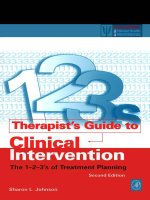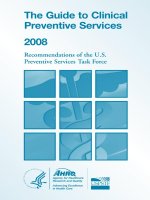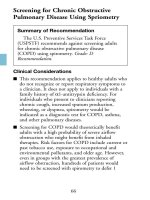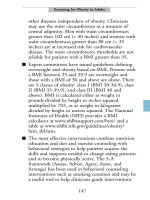The Guide to Clinical Preventive Services 2008 - part 8 potx
Bạn đang xem bản rút gọn của tài liệu. Xem và tải ngay bản đầy đủ của tài liệu tại đây (82.52 KB, 27 trang )
■ Increased IOP, family history, older age, and being
of African American descent place an individual at
increased risk for glaucoma. Older African
Americans have a higher prevalence of glaucoma
and perhaps a more rapid disease progression, and if
it is shown that screening for glaucoma reduces the
development of visual impairment, African
Americans would likely have greater absolute
benefit than whites. People with a limited life
expectancy would likely have little to gain from
glaucoma screening.
■ The natural history of glaucoma is heterogeneous
and not well defined. There is a subgroup of people
with POAG in whom there is either no disease
progression, or the progression is so slow that the
condition would never have an important effect on
their vision. The size of this subgroup is uncertain
and may depend on the ethnicity and age of the
population. Others experience more rapidly
progressing disease, leading to reduced vision-
related function within 10 years. Whether an
individual’s glaucoma will progress cannot be
predicted with precision, but those with higher
levels of IOP and worse visual fields at baseline, and
those who are older, tend to be at greater risk for
the more rapid progression of glaucoma. Whether
the rate of progression of visual field defects remains
uniform throughout the course of glaucoma is
unknown.
174
Screening for Glaucoma
■ Measurement of visual fields can be difficult. The
reliability of a single visual field measurement may
be low; several consistent visual field measurements
are needed to establish the presence of defects.
Dilated opthalmoscopy or slit lamp exam are used
by specialists to examine changes in the optic disc;
however, even experts vary in their ability to detect
glaucomatous optic disc progression. Additionally,
there is no agreed-upon single standard to define
and measure progression of visual field defects.
The primary treatments for POAG reduce IOP; these
include medications, laser therapy, or surgery. These
treatments effectively reduce the development and
progression of small, visual field defects. The
magnitude of their effectiveness, however, in
reducing impairment in vision-related function is
uncertain. Harms caused by these interventions
include formation of cataracts, harms resulting from
cataract surgery, and harms of topical medication.
This USPSTF recommendation was first published by:
Agency for Healthcare Research and Quality. Rockville,
MD, March 2005. .
175
Screening for Glaucoma
abridged. To see the full recommendation statements
and recommendations published after March 2008,
go to .
Section 3.
Recommendations
for Children
■ This USPSTF recommendation addresses screening
for elevated blood levels in children aged 1 to 5
years who are both at average and increased risk,
and in asymptomatic pregnant women.
■ The highest mean blood lead levels in the U.S.
occur in children aged 1-5 years (geometric mean
1.9 µg/dL). Children under 5 years of age are at
greater risk for elevated blood lead levels and lead
Summary of Recommendations
The U.S. Preventive Services Task Force
(USPSTF) concludes that evidence is insufficient
to recommend for or against r
outine screening for
elevated blood lead levels in asymptomatic children
aged 1 to 5 who are at increased risk. Grade: I
Statement.
The USPSTF r
ecommends against routine
screening for elevated blood lead levels in
asymptomatic children aged 1 to 5 years who are
at average risk. Grade: D Recommendation.
The USPSTF r
ecommends against routine
screening for elevated blood lead levels in
asymptomatic pr
egnant women. Grade: D
Recommendation.
179
Screening for Elevated Blood Lead
Levels in Children and Pregnant Women
toxicity because of increased hand-to-mouth
activity, increased lead absorption from the
gastrointestinal tract, and the greater vulnerability
of the developing central nervous system. Risk
factors for increased blood lead levels in children
and adults include: minority race/ethnicity; urban
residence; low income; low educational attainment;
older (pre-1950) housing; recent or ongoing home
renovation or remodeling; pica exposure; use of
ethnic remedies, certain cosmetics, and exposure to
lead-glazed pottery; occupational and para-
occupational exposures; and recent immigration.
Additional risk factors for pregnant women include
alcohol use, smoking, pica, and recent immigration
status.
■ Blood lead levels in childhood, after peaking at
about 2 years of age, decrease during short- and
long-term followup without intervention. Most lead
is stored in bone. High bone lead levels can be
present with normal blood lead levels, so that blood
lead levels often do not reflect the total amount of
lead in the body. This could explain the lack of
effect of blood lead level-lowering measures on
reducing neurotoxic effects.
■ Screening tests for elevated blood lead levels include
free erythrocyte (or zinc) protoporphyrin levels and
capillary or venous blood lead levels. Erythrocyte
(or zinc) protoporphyrin is insensitive to modest
elevations in blood lead levels and lacks specificity.
Blood lead concentration is more sensitive than
180
Screening for Blood Lead Levels
erythrocyte protoporphyrin for detecting modest
lead exposure, but its accuracy, precision, and
reliability can be affected by environmental lead
contamination. Therefore, venous blood lead level
testing is preferred to capillary sampling. Screening
questionnaires may be of value in identifying
children at risk for elevated blood lead levels but
should be tailored for and validated in specific
communities for clinical use.
■ Treatment options in use for elevated blood lead
levels include residential lead hazard-control efforts
(i.e., counseling and education, dust or paint
removal, and soil abatement), chelation, and
nutritional interventions. In most settings,
education and counseling is offered for children
with blood lead levels from 10 to 20 µg/dL. Some
experts have also recommended nutritional
counseling for children with blood lead levels in this
range. Residential lead hazard control is usually
offered to children with blood lead levels ≥20
µg/dL, while chelation therapy is offered to children
with blood lead levels ≥45 µg/dL.
■ Community-based interventions for the primary
prevention of lead exposure are likely to be more
effective, and may be more cost-effective, than
office-based screening, treatment, and counseling.
Relocating children who do not yet have elevated
blood lead levels but who live in settings with high
lead exposure may be especially helpful.
181
Screening for Blood Lead Levels
Community, regional, and national environmental
lead hazard reduction efforts, such as reducing lead
in industrial emissions, gasoline, and cans, have
proven highly effective in reducing population
blood lead levels.
This USPSTF recommendation was first published in:
Pediatrics. 2006;118:e2514-2518.
182
Screening for Blood Lead Levels
183
Clinical Considerations
■ Dental disease is prevalent among young children,
particularly those from lower socioeconomic
populations; however, few preschool-aged children
ever visit a dentist. Primary care clinicians are often
the first and only health professionals whom
children visit. Therefore, they are in a unique
position to address dental disease in these children.
■ Fluoride varnishes, professionally applied topical
fluorides approved to prevent dental caries in young
children, are adjuncts to oral supplementation.
Their advantages over other topical fluoride agents
Prevention of Dental Caries in
Preschool Children
Summary of Recommendations
The U.S. Preventive Services Task Force
(USPSTF) recommends that primar
y care
clinicians prescribe oral fluoride supplementation
at currently recommended doses to preschool
children older than 6 months of age whose
primary water source is deficient in fluoride.
Grade: B Recommendation.
The USPSTF concludes that the evidence is
insufficient to recommend for or against r
outine
risk assessment of preschool children by primary
care clinicians for the prevention of dental disease.
Grade: I Statement.
Prevention of Dental Caries in Preschool Children
184
(mouth-rinse and gel) include ease of use, patient
acceptance, and reduced potential for toxicity.
■ Dental fluorosis (rather than skeletal fluorosis) is the
most common harm of either oral fluoride or
fluoride toothpaste use in children younger than 2
years in the United States. Dental fluorosis is
typically very mild and only of aesthetic
importance. The recommended dosage of fluoride
supplementation was reduced by the American
Dental Association in 1994, which is likely to
decrease the prevalence and severity of dental
fluorosis. The current dosage recommendations are
based on the fluoride level of the local community’s
water supply and are available online at
www.ada.org. The primary care clinician’s
knowledge of the fluoride level of his or her
patients’ primary water supply ensures appropriate
fluoride supplementation and minimizes risk for
fluorosis.
This USPSTF recommendation was first published in:
Am J Prev Med. 2004;26(4)326-329.
Clinical Considerations
■ This USPSTF screening recommendation applies
only to infants who do not have obvious hip
dislocations or other abnormalities evident without
screening. DDH represents a spectrum of anatomic
abnormalities in which the femoral head and the
acetabulum are aligned improperly or grow
abnormally. DDH can lead to premature
degenerative joint disease, impaired walking, and
pain. Risk factors for DDH include female gender,
family history of DDH, breech positioning, and in
utero postural deformities. However, the majority of
cases of DDH have no identifiable risk factors.
■ Screening tests for DDH have limited accuracy. The
most common methods of screening are serial
physical examinations of the hip and lower
extremities, using the Barlow and Ortolani
procedures, and ultrasonography. The Barlow
examination is performed by adducting a flexed hip
with gentle posterior force to identify a dislocatable
Screening for Developmental Dysplasia
of the Hip
185
Summary of Recommendation
The USPSTF concludes that evidence is
insufficient to recommend r
outine screening for
developmental dysplasia of the hip in infants as a
means to prevent adverse outcomes. Grade: I
Statement.
hip. The Ortolani examination is performed by
abducting a flexed hip with gentle anterior force to
relocate a dislocated hip. Data assessing the relative
value of limited hip abduction as a screening tool
are sparse and suggest the test is of little value in
early infancy and is of somewhat greater value as
infants age.
■ Treatments for DDH include both nonsurgical and
surgical options. Nonsurgical treatment with
abduction devices is used in early treatment and
includes the commonly prescribed Pavlik method.
Surgical intervention is used when DDH is severe
or diagnosed late or after an unsuccessful trial of
nonsurgical treatments. Evidence of the effectiveness
of interventions is inconclusive because of a high
rate of spontaneous resolution, absence of
comparative studies of intervention versus
nonintervention groups, and variations in surgical
indications and protocols. Avascular necrosis of the
hip is the most common and most severe potential
harm of both surgical and nonsurgical interventions
and can result in growth arrest of the hip and
eventual joint destruction with significant disability.
References
1. Lehmann HP, Hinton R, Morello P, Santoli J.
Developmental dysplasia of the hip practice guideline:
technical report. Committee on Quality Improvement,
and Subcommittee on Developmental Dysplasia of the
Hip. Pediatrics. 2000;105(4):E57.
186
Screening for Hip Dysplasia
187
2. Bialik V, Bialik GM, Blazer S, Sujov P, Wiener F, Berant
M. Developmental dysplasia of the hip: a new approach
to incidence. Pediatrics. 1999;103(1):98-99.
3. Barlow T. Early diagnosis and treatment of congenital
dislocation of the hip. J Bone and Joint Surgery.
1962;44:292-301.
4. Standing Medical Advisory Committee. Screening for
the detection of congenital dislocation of the hip. Arch
Dis Child. 1986;61(9):921-926.
5. Cashman JP, Round J, Taylor G, Clarke NM. The
natural history of developmental dysplasia of the hip
after early supervised treatment in the Pavlik harness. A
prospective, longitudinal followup. J Bone Joint Surg Br.
2002;84(3):418-425.
6. Konigsberg DE, Karol LA, Colby S, O’Brien S. Results
of medial open reduction of the hip in infants with
developmental dislocation of the hip. J Pediatr Orthop.
2003;23(1):1-9.
This USPSTF recommendation was first published in
Pediatrics. 2006;117:898-902.
Screening for Hip Dysplasia
Clinical Considerations
■ Screening adolescents for idiopathic scoliosis is
usually done by visual inspection of the spine to
look for asymmetry of the shoulders, scapulae, and
hips. A scoliometer can be used to measure the
curve. If idiopathic scoliosis is suspected,
radiography can be used to confirm the diagnosis
and to quantify the degree of curvature.
■ The health outcomes of adolescents with idiopathic
scoliosis differ from those of adolescents with
secondary scoliosis (ie, congenital, neuromuscular,
or early onset idiopathic scoliosis). Idiopathic
scoliosis with onset in adolescence may have a
milder clinical course.
1
■ Conservative interventions to treat curves detected
through screening include spinal orthoses (braces)
and exercise therapy, but they may not significantly
improve back pain or the quality of life for
adolescents diagnosed with idiopathic scoliosis.
188
Summary of Recommendation
The U.S. Preventive Services Task Force
(USPSTF) recommends against the r
outine
screening of asymptomatic adolescents for
idiopathic scoliosis. Grade: D Recommendation.
Screening for Idiopathic Scoliosis in
Adolescents
Screening for Idiopathic Scoliosis in Adolescents
189
■ The potential harms of screening and treating
adolescents for idiopathic scoliosis include
unnecessary follow-up visits and evaluations due to
false positive test results and psychological adverse
effects, especially related to brace wear. Although
routine screening of adolescents for idiopathic
scoliosis is not recommended, clinicians should be
prepared to evaluate idiopathic scoliosis when it is
discovered incidentally or when the adolescent or
parent expresses concern about scoliosis.
Reference
1. Weinstein SL, Dolan LA, Spratt KF, Peterson KK,
Spoonamore MJ, Ponseti IV. Health and function of
patients with untreated idiopathic scoliosis: a 50-year
natural history study. JAMA. 2003;289(5):559-567.
This USPSTF recommendation was first published by:
Agency for Healthcare Research and Quality, Rockville,
MD. June 2004. .
Clinical Considerations
■ Dyslipidemias are abnormalities of lipoprotein
metabolism and include elevations in TC, LDL-C,
or triglycerides or deficiencies of HDL-C. These
disorders can be acquired or familial; monogenic
dyslipidemias are related to genetic conditions such
as familial hypercholesterolemia in some
individuals. Multifactorial dyslipidemias are due to
risk factors including environmental factors (obesity,
diet) or currently unidentified genetic factors. This
recommendation applies to all asymptomatic
individuals from birth to age 20.
■ Because normal lipid levels have been strongly
associated with the risk of coronary heart disease
(CHD) events in adulthood, and early
identification and lipid-lowering intervention in
certain populations of adults can prevent CHD
events, much attention has been directed at
screening individuals for dyslipidemia at young ages
190
Screening for Lipid Disorders in Children
Summary of Recommendation
The U.S. Preventive Services Task Force
(USPSTF) concludes that the evidence is
insufficient to recommend for or against r
outine
screening for lipid disorders in infants, children,
adolescents, or young adults (up to age 20). Grade:
I Statement.
(e.g., childhood). Among children and adolescents,
3 groups may be identified through screening:
1. Children with undiagnosed monogenic
dyslipidemias such as familial
hypercholesterolemia.
2. Those with undiagnosed secondary causes
of dyslipidemia.
3. Those with multi-factorial dyslipidemia
(polygenetic or related to risk-factors).
However, the clinical health benefits shown in
adults identified and treated for dyslipidemia have
not been studied in children, making the role of
screening children uncertain.
■ Children and adolescents with diabetes may be at
especially high risk for dyslipidemia and
cardiovascular events. Screening children and
adolescents with diabetes for dyslipidemia has been
recommended by other groups as a part of
appropriate care for these children.
■ The use of family history as a screening tool for
dyslipidemia has variable accuracy largely because
definitions of a positive family history and lipid
threshold values vary substantially. Screening using
family history as defined by the National
Cholesterol Education Program (NCEP) and the
American Academy of Pediatrics (AAP) has been
shown to have high rates of false negative results.
Screening for Lipid Disorders in Children
191
■ If clinicians choose to screen for dyslipidemia, the
preferred screening tests are TC and HDL-C on
nonfasting or fasting samples; calculating LDL-C
requires fasting samples.
This USPSTF recommendation was first published in:
Pediatrics. 207;120:e215-e219.
192
Screening for Lipid Disorders in Children
Newborn Hearing Screening
193
NOTE: The USPSTF revised its recommendation
on this topic during publication of The Guide to
Clinical Pr
eventive Services 2008. For the most
r
ecent recommendation, please visit our Web site
at or the
USPSTF’s Electronic Preventive Services Selector
(ePSS) at . You can search the
ePSS for recommendations by patient age, sex, and
pregnancy status, and you can download the
recommendations as well as receive automatic
updates to your PDA.
Clinical Considerations
■ It is important to measure and monitor growth over
time in all children as an indicator of health and
development. The number of children and
adolescents who are overweight has more than
doubled since the early 1970s, with the prevalence
of overweight (BMI > 95th percentile for age and
sex) for children aged 6 to 19 years now at
approximately 15 percent. The conclusion that
there is insufficient evidence to recommend for or
against screening for overweight in children and
adolescents reflects the paucity of good-quality
evidence on the effectiveness of interventions for
this problem in the clinical setting. There is little
evidence for effective, family-based or individual
approaches for the treatment of overweight in
children and adolescents in primary care settings.
The Centers for Disease Control and Prevention’s
(CDC’s) Guide to Community Preventive Services
has identified effective population-based
194
Screening and Interventions for
Overweight in Children and Adolescents
Summary of Recommendation
The U.S. Preventive Services Task Force
(USPSTF) concludes that the evidence is
insufficient to recommend for or against r
outine
screening for overweight in children and
adolescents as a means to prevent adverse health
outcomes. Grade: I Statement.
interventions that have been shown to increase
physical activity, which may help reduce childhood
overweight.
■ BMI (calculated as weight in kilograms divided by
height in meters squared) percentile for age and sex
is the preferred measure for detecting overweight in
children and adolescents because of its feasibility,
reliability, and tracking with adult obesity measures.
BMI values are CDC population-based references
for comparison of growth distribution to those of a
larger population. Being at risk for overweight is
defined as a BMI between the 85th and 94th
percentile for age and sex, and overweight as a BMI
at or above the 95th percentile for age and sex.
Disadvantages of using BMI include the inability to
distinguish increased fat mass from increased fat-
free mass, and reference populations derived largely
from non-Hispanic whites, potentially limiting its
applicability to non-white populations. Indirect
measures of body fat, such as skinfold thickness,
bio-electrical impedance analysis, and waist-hip
circumference, have potential for clinical practice,
treatment, research, and longitudinal tracking,
although there are limitations in measurement
validity, reliability, and comparability between
measures.
■ Childhood overweight is associated with a higher
prevalence of intermediate metabolic consequences
and risk factors for adverse health outcomes, such as
insulin resistance, elevated blood lipids, increased
195
Screening for Overweight in Children and Adolescents
196
Screening for Overweight in Children and Adolescents
blood pressure, and impaired glucose tolerance.
Severe childhood overweight is associated with
immediate morbidity from conditions such as
slipped capital femoral epiphysis, steatohepatitis,
and sleep apnea. Medical conditions new to this age
group, such as type 2 diabetes mellitus, represent
“adult” morbidities that are now seen more
frequently among overweight adolescents. For most
overweight children, however, medical
complications do not become clinically apparent for
decades.
This recommendation was first published in: Pediatrics.
2005;116(1):205-209.
197
Clinical Considerations
■ Screening for sickle cell disease in newborns is
mandated in all 50 States and the District of
Columbia. Most States use either thin-layer
isoelectric focusing (IEF) or high performance
liquid chromatography (HPLC) as the initial
screening test. Both methods have extremely high
sensitivity and specificity for sickle cell anemia.
Specimens must be drawn prior to any blood
transfusion due to the potential for a false negative
result as a result of the transfusion. Extremely
premature infants may have false positive results
when adult hemoglobin is undetectable.
1
■ All newborns should undergo testing regardless of
birth setting. In general, birth attendants should
make arrangements for samples to be obtained, and
the first physician to see the child at an office visit
should verify screening results. Confirmatory testing
should occur no later than 2 months of age.
Screening for Sickle Cell Disease in
Newborns
Summary of Recommendation
The U.S. Preventive Services Task Force
(USPSTF) recommends scr
eening for sickle cell
disease in newborns. Grade: A Recommendation.
Screening for Sickle Cell Disease in Newborns
198
■ Children with sickle cell anemia should begin
prophylactic penicillin by 2 months of age and
receive pneumococcal immunizations at
recommended intervals.
Reference:
1. National Institutes of Health. The Management of
Sickle Cell Disease, 4th Ed. Revised June 2002. NIH
National Heart, Lung, and Blood Institute. NIH
Publication No. 02-2117. Available at:
/>ngt.pdf. Accessed August 2, 2007.
This USPSTF recommendation was first published by
Agency for Healthcare Research and Quality, Rockville, MD.
September 2007. .









